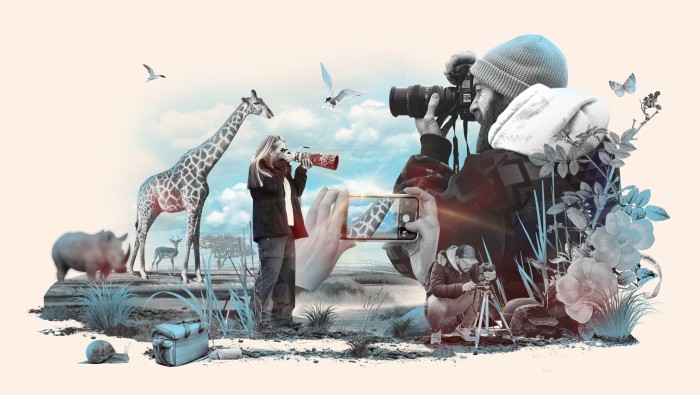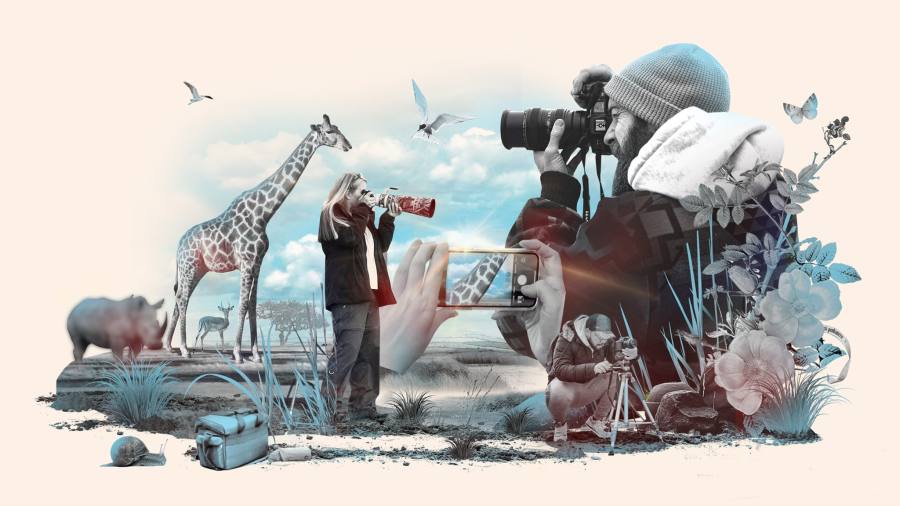[ad_1]

The Wildlife Photographer of the Year exhibition showcases beautiful pictures of rare and remarkable creatures. To create these images, dedicated experts crawled through leech-infested swamps, sailed through ice-strewn seas and crouched for hours in cramped hides.
Coming home, I had just one thought: not bad for a bunch of professionals, but this lot would never make it as amateurs.
I know what I am talking about. I have been taking substandard nature photographs for decades. Some have even merited an exhibition of their own. We had to put something on the walls of our downstairs loo.
In my view, none of the contributors to the show at London’s Natural History Museum has grasped the basic principles of bad nature photography.
In this endeavour, the canonic image reduces the animal to a small, blurred blob in one corner of the frame. Ideally, it should be fleeing the snapper as he or she crashes through the undergrowth or roars up in a Jeep.
“Here are some more impala behinds,” I told friends proudly, showing them my safari photos.
“Is that a hairy caterpillar?” one of them asked, peering at another snap.
“No,” I said. “That is a rhinoceros. It was a long way off.”
I inherited my hobby from my father. He was a titan in the field. One evening every year he would produce racks of slides and corral the family together. Sitting in the dark, stupefied with boredom and lulled by the whirring of the projector, I would drift in and out of consciousness.
“I think this might be one of a crossbill,” he would say.
“Isn’t it just a bit of fluff on the slide?” my mother would ask, brightly.
“No!” he would snap, blowing on the equipment. Miraculously, the crossbill would take flight.
Bad nature photography was easier then. Analogue equipment limited the number of shots you could take. Little of the process was automated. Long lenses were expensive.
Digital cameras do the bulk of the decision making these days. It costs nothing to junk shots that flop. Tolerable telephoto lenses retail for under £1,000. You can take decent landscapes and wildlife shots with a smartphone, too.
The democratisation of nature photography is welcome. You do not have to schlep to Tanzania or South Georgia to get pleasing results. A sharp picture of a garden blue tit is a thing of wonder. Just do not expect relatives to say so.
“It’s your children I feel sorry for,” my father-in-law observed sombrely, after I had shown him 43 snaps of identical godwits. “Think how many photos they’ll have to throw away when you die.”
I am fine with that. But I do fret over the beauty standards created by photo-editing software. This is causing a whole new genre of bad nature photos. It turns photography into digital painting by numbers. Taking pictures in the open air becomes a starting point, rather than an end in itself.
The naffest products of this technology are super-sharp, supersaturated landscapes. These crop up on the walls of some budget hotels and as starting screens on digital devices. Industrious photographers have stitched together multiple images and tweaked them into the fantasy of the rugged outdoors. This world is bathed in permanent sunshine, except at night. Then, constellations wheel overhead in perfect detail, at the same intensity as the street lights of a distant village.
Tweaked wildlife photos are equally common. I’m not referring here to obvious fakes like the “Norwegian blue owl” which did the rounds on social media recently. Instead, I’m referring to real animals that have been idealised. Typically, the animal is perfectly lit. It is looking directly out of the frame, as if making conscious eye contact with the viewer.
Nature is rarely like this, particularly during the British winter. Right now, the countryside is generally a study in low-contrast browns, greens and greys. Birds feature as hunched balls of feathers. Food is scarce. Animals are not at their best.
This was borne home to me by a trip to a seal haul-out on Tyneside. Scrutinising my photographs of a bull seal later, I noticed that moulting had given him a comical, moth-eaten tonsure. He had a long string of mucus dangling from one nostril.
He looked cold, hungry and fed up. The summer mackerel shoals and the mating season were a long way off. I hovered the cursor over the “match and patch” function. Then paused.
My feeling is that editing software is best used as an adjunct to taking photographs. It is not the main event. Clever tweakery must have gone into some of the images at the Natural History Museum. But not every cactus bee in Karine Aigner’s contest-winning shot of a spherical breeding cluster was in perfect focus.
Jose Fragozo’s outstanding picture “The Disappearing Giraffe” showed just the hindquarters of an animal galloping under a new elevated railway in Kenya. It said more about wildlife in the Anthropocene than any standard safari shot: space for nature is decreasing fast.
I would have automatically deleted this photo because the animal’s head is hidden. It is a matter of cliché that art is more about seeing than doing.
Next time a visitor goes to use our downstairs loo, I will tell them: “While you’re in there, look out for my photo ‘Disgruntled Seal with a Head Cold’. It really is one of my finest efforts.”
Jonathan Guthrie is head of Lex
Find out about our latest stories first — follow @FTProperty on Twitter or @ft_houseandhome on Instagram
[ad_2]
